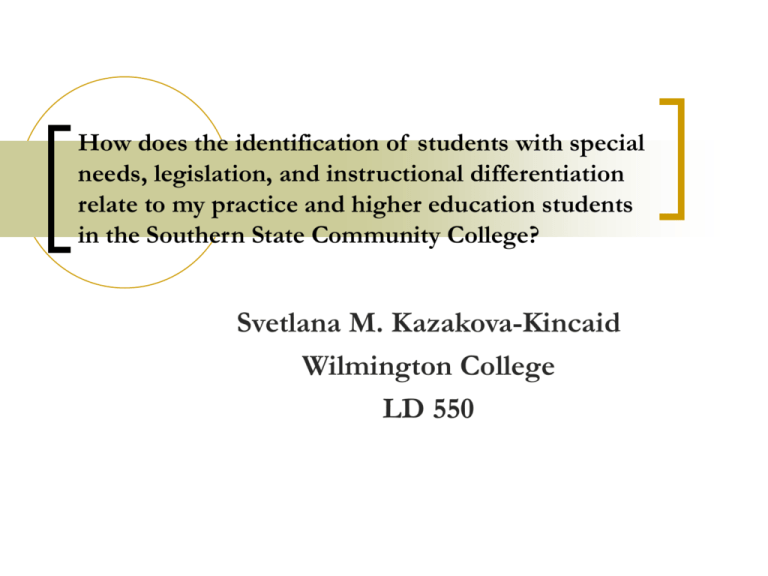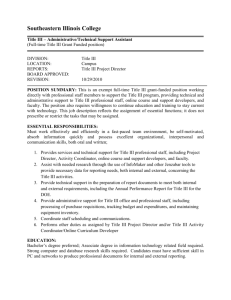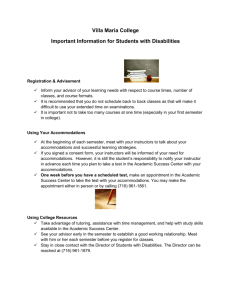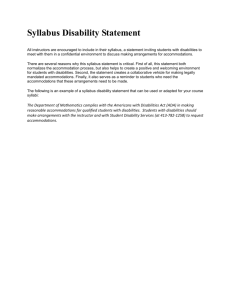Final PPT
advertisement

How does the identification of students with special needs, legislation, and instructional differentiation relate to my practice and higher education students in the Southern State Community College? Svetlana M. Kazakova-Kincaid Wilmington College LD 550 Southern State Community College SSCC is two-year community college It was established in 1975 as Southern State General and Technical College Became Southern State Community College in 1977 Serves a five-county: Adams, Brown, Clinton (Wilmington City), Highland (Hillsboro), and Fayette (Washington Court House) Counties It has a campus or an operating facility Specific career training Transfer students Adult basic literacy courses and workforce training programs Southern State Community College Advantages: Very affordable, accessible, and descent quality education In 2009 – 2010 academic year SSCC chose not to raise its tuition Increase in enrollment by 30 percent 3,500 students attending Disadvantages: No room and board opportunities for students Very little ethnic diversity Southern State Community College Classrooms: Newly built Very bright and conducive for learning Technology is a priority (Smart boards, Computer labs, Mobile labs) Classes: English 100: preparation for College Writing English 101: Introduction to an Essay English 102: English Essay and Composition English 103: Introduction to Literature Southern State Community College Student age range: 17 to 60 Students per class: 2- 20 Gender ratio: 2:20, males to females Student characteristics: mostly serving general education students with very few diagnosed with Learning Disabilities or more intensive disorders like highly functioning Autism. Syllabus: “Students with disabilities may contact the Disabilities Service Office, Central Campus, at 800-628-7722 or 937-393-3431. Accommodations for this class will not be made unless the requirements for those accommodations are communicated to me (your instructor) through Connie Horne, Disabilities Services Coordinator” Design of the instruction Core curriculum, as outlined in the SSCC curriculum and catalogue Attempt to modify instruction to student’s instructional level: Allowing Dictaphones Guided notes Extended time Two versions of the test or in-class handouts Social skills even with modeling because we are talking about young adults or adults with formed habits Students’ accommodations = testing and all class work Assessment Assessments and instruction is done with basic accommodations Student progress monitoring: Test scores Effort and motivation External circumstances Relevant Events From My Practice Not applicable: Identification process Parental involvement Referring and assessments By the time they enter SSCC they either have been Identified or have never been referred Common Issues Some students are facing significant reading challenges, which is consistent with research findings reported by Kavale and Reese, which in turn affects student’s spelling and writing (Kavale and Reese qtd. in Turnbull, Turnbull and Wehmeyer 2007) Classes are reading and writing intensive classes Students are feeling overwhelmed by: The idea of getting started Struggling to organize and use mechanics of writing even with a tutor’s assistance Issues with spelling and writing papers (in-class assignments) legibly Common Issues Deal with young adult and/or adult population Parents do not have any access to Their records Work samples and information regarding their college achievement No useful input or parent advocacy RTI The basic RTI model can be utilized, but: No time to work with students, who do not respond to the generally effective instruction No time to work with the next available research based methodology System Shortcomings No requirement to have general education or special education background Having an Ed. D. or Ph. D in the content area, or a Master’s Basic training on methods of teaching and learning No adequate training or knowledge provided on how to plan a universal design for learning or provide accommodations based on anecdotal data Conclusion K-12 education system = changes System = generations of unidentified children, nowadays adults Educational departments = more or less adequate training Higher education teachers do not receive adequate training Standard placement test practices = huge barrier for LD students Need for adjustment in the legislature system Adjustment of the admissions tests Implementation of strategies and accommodations







